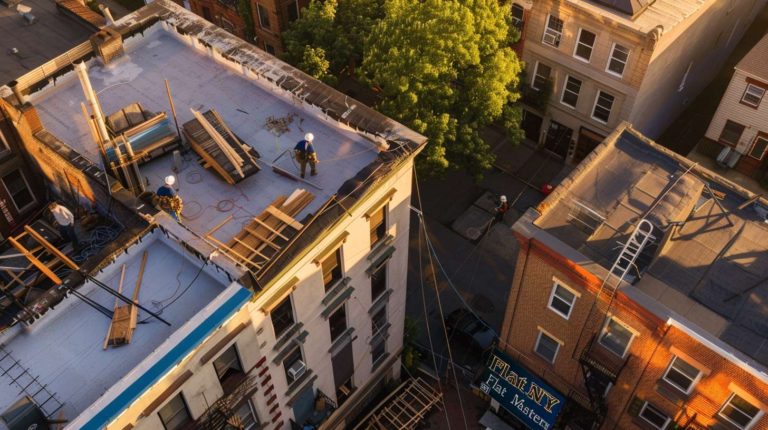Professional Flat Roof Wall Junction Sealing Services
Look, I've been sealing flat roofs against walls in Queens for over two decades, and I can tell you right now - this is where most roof failures start. That junction where your flat roof meets the wall? It's basically the Achilles heel of your entire roofing system.
Just last month on 35th Avenue in Astoria, I had a customer call me frantically about water streaming down their interior wall during a storm. Guess what the problem was? The wall junction seal had completely failed, and water was pouring in like Niagara Falls. This stuff doesn't mess around.
Why Flat Roof Wall Junction Sealing Matters More Than You Think
Here's the thing about sealing flat roofs against walls - it's not just about slapping some caulk where the roof meets the building. The thermal expansion and contraction we get here in Queens, especially with those brutal winters followed by scorching summers, creates constant movement between your roof membrane and the wall structure.
I've seen expensive EPDM membranes and modified bitumen systems fail within two years because the contractor didn't properly address the wall junction. And trust me, once water finds its way behind your wall system, you're looking at structural damage that'll cost you ten times more than doing it right the first time.
The salt air from the East River doesn't help either - it accelerates the breakdown of inferior sealants faster than you'd believe.
How We Properly Seal a Flat Roof Against a Wall
When people ask me how to seal a flat roof against a wall, I always start with the fundamentals. First, you need to understand that this isn't a DIY weekend project. The materials alone - quality polyurethane sealants, proper flashing, membrane adhesives - can run $200-400 for a typical residential application, and that's before you factor in the specialized tools and experience needed to do it right.
Our process starts with complete removal of the existing sealant. I don't care if it looks "okay" - if we're doing this job, we're doing it to last 15-20 years, not patch it for another two seasons.
We then install a proper base flashing system that extends at least 8 inches up the wall and 6 inches onto the roof surface. The membrane gets mechanically fastened, not just adhesive-bonded, because I've seen too many adhesive failures when Queens gets hit with those 60+ mph winds during nor'easters.
The Technical Side That Most Contractors Skip
Here's where experience really matters - the termination detail at the top of the wall flashing. Most guys just caulk it and call it done. Wrong. We create a proper termination bar system, typically using aluminum or stainless steel bars mechanically fastened through the flashing and into the wall structure, then seal behind and in front of the bar with high-grade polyurethane.
The membrane itself needs to be properly primed - and I mean really primed, not just wiped down. We use a two-part adhesive system that bonds to both the roof membrane and the wall substrate. On masonry walls, which are common in Queens, we often need to apply a masonry primer first because these old brick buildings can be porous as a sponge.
Oh, and another thing about drainage - the roof surface needs to slope away from the wall at minimum 1/4 inch per foot. I can't tell you how many times I've seen "professional" installations where water actually ponds against the wall junction. That's asking for trouble.
Material Selection for Queens Weather Conditions
Not all sealants are created equal, especially in our climate. We typically use either Tremco Spectrem 1 or Dow Corning 795 for the primary seal - these polyurethane sealants handle our temperature swings without losing adhesion. The cheap stuff you get at Home Depot? Forget about it. It'll crack and pull away within two seasons.
For the flashing membrane, we prefer Carlisle or GAF modified bitumen with a polyester reinforcement mat. EPDM can work, but the seaming at corners requires more expertise, and frankly, most contractors mess it up.
The fasteners matter too - we use corrosion-resistant screws with EPDM washers, spaced every 6 inches along the termination bar. Stainless steel in coastal areas, galvanized inland.
Common Mistakes That Cost Queens Property Owners Thousands
I've seen contractors try to seal wall junctions with roofing cement. Don't laugh - it happens more than you'd think. Roofing cement is great for temporary patches, but it's not a long-term solution for a critical junction like this.
Another mistake? Not addressing the wall surface preparation. If you're sealing against painted brick or concrete block, that paint needs to come off first. Sealant adhering to paint is only as good as the paint's adhesion to the substrate, and paint fails.
Then there's the "caulk and pray" approach - just running a bead of caulk along the joint without proper flashing. This might stop leaks for a few months, but it's guaranteed to fail.
When to Call Flat Masters NY
Look, if you're seeing water stains on interior walls below your roof line, don't wait. Water damage spreads fast, and what starts as a $800 sealing job can turn into a $8,000 remediation project if you let it go.
We've been handling flat roof wall junction sealing throughout Queens since 2003. My crew knows these buildings - the 1920s brick construction in Forest Hills, the post-war concrete block buildings in Elmhurst, the newer construction in Long Island City. Each type requires a slightly different approach.
If you're dealing with recurring leaks at wall junctions, or if you're seeing your current sealant pulling away from either the roof or wall surface, give us a call at (917) 994-7618. We'll come out, assess the situation, and give you an honest evaluation of what needs to be done.
Because here's the bottom line - proper flat roof wall junction sealing isn't just about stopping leaks today. It's about protecting your investment for the next two decades. And in Queens, where property values keep climbing, that protection is worth every penny.


